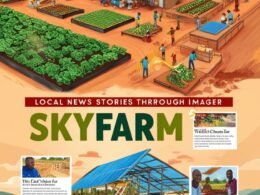CTA Top20 Innovations that Benefit Smallholder Farmers.
Cowpea then maize: An innovative approach to intercropping
By Gabriel Y. A. Adukpo, Department of Agriculture, Obuasi Municipal Assembly, Obuasi-Ashanti, Ghana
In 2001, Kwabena Mensah and his wife, Mary Gwanwaa, like many farm families in Ghana’s Eastern Region, experienced a second consecutive year of almost total crop failure. Growing maize and cowpeas on a one-acre (0.4 ha) piece of land was challenging. Their crops had withered and died when rains stopped during the growing season. This experience led them to reassess and adapt their farming methods, which brought about a change in fortunes that offered new hope to many more farmers.
Mensah and Gwanwaa’s innovation was simple. The couple had followed a typical approach to intercropping maize and cowpea crops as recommended by the extension officers. This consisted of planting alternative rows of maize and cowpeas, but only sowing the cowpeas once the maize had reached the tasselling stage. Having previously lost both crops due to rain failure, they reasoned that the chances of a harvest would be improved if they changed the sequence and planted the cowpea first. They believed this would enable the maize to benefit from nitrogen fixed in the soil by the leguminous cowpea crop, increasing the chances that both crops would reach maturity and yield a harvest should the rainy season be cut short again.
Farmers innovate
In 2002, the couple sowed cowpeas 10 days before the maize. The results were significant. Firstly, both crops reached maturity, with the maize yielding approximately 2 tonnes/ha, 11% more than the average for other farmers in the district. They also harvested around 400 kg of cowpeas, which they sold for Euro 320. Their success encouraged several of their neighbors to follow their lead: 14 farm families in their vicinity have adopted the cowpea-first sequence. The practice has also been recognized by the local extension officer, who is happy that many other farmers have adopted this innovative approach to intercropping; cowpea production—previously little practiced in the area—is more popular as a result.
Farmers need to follow good agricultural practices when using the technique. The alternate rows of maize and cowpea should be spaced 40 cm apart, with precise spacing for the plants within the row—20 cm for cowpea and 40 cm for maize. While most farmers prefer the early-maturing ‘Asontem’ cowpea variety, which matures in just 60 days, more than one variety should be planted, including erect and semi-erect types.
NPK fertilizer is essential for maize if soils are poor and can also benefit cowpea crops. However, top dressing of maize with nitrogen fertilizer—normally carried out when plants are knee-high—is not necessary as the cowpea plants are fixing atmospheric nitrogen in the plant root zone which the maize plants can access. Other recommendations include timely weeding, control of insect pests in cowpeas at 10-day intervals, and use of insecticides to control stem borers in maize. Finally, to maintain a healthy field, farmers are advised to rotate their maize/cowpea intercrop with cassava and vegetables and include a fallow.
Multiple benefits
Eliminating the need to apply top dressing fertilizer reduces overall production costs and is one of several benefits of this innovative intercropping technique. Crop productivity and soil health are also improved, with the maize plants able to make immediate use of nitrogen fixed by cowpeas. Previously, some of these nutrients would have been lost to leaching, evaporation, or weed uptake. Importantly, although labor requirements are not reduced, the demand for labor is better spaced and therefore more manageable. When using the traditional cropping method, both crops needed to be harvested in close succession, which put pressure on families—especially women—and made it difficult to dry the crops before storage. Under the new system, the cowpea is harvested several weeks before the maize, and these problems are avoided.
For extension officers to learn from farmers like Mensah and Gwanwaa and sharing the innovative approach to intercropping more widely is relatively uncommon in Ghana. While Research-Extension-Farmer Linkage Committees (RELCs) meet annually at national, regional, and district levels to identify researchable problems, communication of solutions tends to be top-down. Ideally, the new planting sequence should be further tested and evaluated under a variety of conditions and, if appropriate, be disseminated by extension officers through demonstrations, farmer field schools, and other channels. Researchers should also be encouraged, through the RELCs, to conduct further studies on the technique, investigating issues such as pest and disease control, plant spacing, and socio-economic impacts.
Meeting the potential
Additional research would help to ensure that the potential of this innovative approach to intercropping is fully realized, bringing with it wide-ranging benefits. Successful intercropping can help farmers maximize food production, strengthening food and nutrition security. Cowpea, in particular, is an affordable source of good-quality protein. More productive farming also has knock-on benefits of health, job and wealth creation, and sustainable livelihoods and can help reduce rural-to-urban migration.
At the field level, well-managed intercropping reduces soil erosion and, by supporting diversification, reduces the risk of total crop failure in the event of erratic rainfall. Socially, better spacing of crops across the season relieves some of the pressure that falls on women associated with harvesting, drying, and threshing. Kwabena Mensah and Mary Gwanwaa’s innovation, though seemingly simple, is easy to adopt and quick to bring results. It offers real hope for improved livelihood and quality of life, social fairness, and environmental sustainability.









